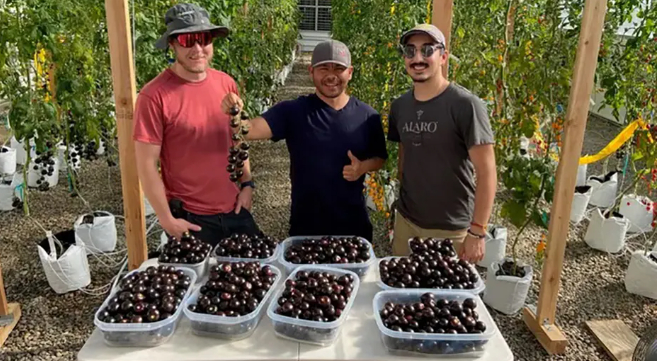November 26, 2025 | 08:58 GMT +7
November 26, 2025 | 08:58 GMT +7
Hotline: 0913.378.918
November 26, 2025 | 08:58 GMT +7
Hotline: 0913.378.918

Trays of purple tomatoes.
About the size and shape of a cherry tomato, the new tomato is a dark, gothic purple on the outside and showcases shades ranging from lavender to royal purple on the inside.
This pageantry of purples is more than just for show. The color is indicative of the nutritional value of the purple tomato and the science behind its creation.
The purple tomato was developed by professor and founder of Norfolk Healthy Produce Cathie Martin. According to Norfolk Healthy Produce CEO Nathan Pumplin, Martin was looking for ways to improve the nutrition and health attributes of foods, such as tomatoes.
Martin discovered that by combining genes from the snapdragon, an edible flower, with the tomato, a purple pigment and additional nutrients are produced in the tomato fruit.
The nutrients are known as anthocyanins, which are antioxidants found in blackberries, grapes, eggplants and other purple fruits and vegetables, Pumplin said. It is these nutrients that give certain plants their striking color.
Additionally, he noted that these antioxidants provide a variety of health benefits, such as anti-cancer and anti-flammatory properties, and aid in heart, lung and neurological health.
"The purple tomato is extremely special because it fits in our conversation right now about health and nutrition, about how important it is to improve the diet of everybody in the world, especially people in the U.S.," Pumplin said. "I think it's great for us to think about how we get more nutrition and the choices that we make around food."
Despite the benefits of anthocyanins, most Americans do not consume enough of them. Pumplin said the average American eats about 12 mg per day, when they should be eating 10-20 times the amount. This amount is equivalent to a single serving of blueberries, but most people do not eat that many blueberries.
This nutrient deficiency in the American diet is one of the reasons why Martin and her team selected the tomato for development.
According to Pumplin, Americans eat 20 times more tomatoes than they eat blueberries. This presented an opportunity for a genetic crossover between tomatoes and purple-blue fruits and vegetables.
"This is really an excellent way to get more anthocyanins, more of these purple antioxidants, into your diet every day," he said.
And of course, the million-dollar question: How does it taste?
Much like a cherry tomato, according to Pumplin.
"We really love the flavor," he said. "It's pretty low on acid, and so you get a very umami, a very savory, earthy kind of tomato flavor."
Purple tomatoes will become available in select grocery stores for the first time starting in late spring and early summer.
For people interested in testing their green thumbs when growing the purple fruit, seeds can now be purchased on the Norfolk Healthy Produce website.
Growing the purple tomato plant has been tested throughout the U.S., from California to Connecticut, Pumplin said.
"They've done extremely well. They're very hardy plants. They're very vigorous," he noted. "Really, they're just a tomato like any other tomato. So even though the fruit is purple, they're no different from other indeterminate tomatoes that growers will grow in their garden."
(Fox9)

(VAN) Brazil's COP30 presidency pushed through a compromise climate deal on Saturday that would boost finance for poor nations coping with global warming but that omitted any mention of the fossil fuels driving it.

(VAN) Poultry farmers in the UK have been warned that they could face one of the worst winters yet for bird flu.

(VAN) Prices of main-crop paddy have risen sharply, with jasmine rice hitting 16,100 baht per tonne — the highest level in years.

(VAN) In Brazil, FAO unveiled a series of reports and initiatives showing how sustainable agrifood systems are a solution to the climate crisis.

(VAN) With names like neodymium and dysprosium, rare-earth elements sound exotic — and their perceived scarcity has only added to the mystique.

(VAN) In a new study published in Trends in Biotechnology, researchers used a gene-editing technology called CRISPR to increase a fungus's production efficiency and cut its production-related environmental impact by as much as 61%- all without adding any foreign DNA.

(VAN) A top official in Beijing’s Cop delegation says China is committed to clean energy – but US’s absence is a problem.